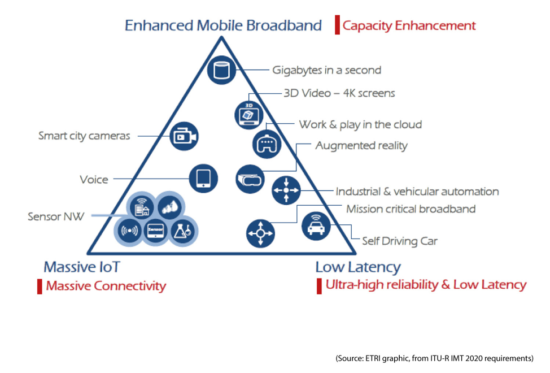































5G is a capital improvement project the size of the entire planet, replacing architecture created this century with another one that aims to lower energy consumption and maintenance costs while increasing efficiencies. In 2035, 5G is projected to enable$12.3 trillion of global economic output and support 22 million jobs. It's a gamble, for sure, on the future of transmission technology - contingent upon consumers' willingness to upgrade.
5G will introduce three new use cases, the most publicized offering users' theoretical tens of Gbps (reality being more 1 Gbps). In addition to this use case, 5G will allow you to get off the mobile network faster and also provide enhanced access into cloud services like AWS, Azure or GCP. This allows you to take advantage of the network and right into your cloud with such services as mobile office applications, interactive entertainment, and games (think AR/VR).
With allof the speculation and possibilities for 5G and what it really means, we're taking a stab at showing why it really does matter to Web Scale companies.
Each of the blogs in this series covers the web applications of these new services and how this will help Web players intelligently utilize the virtual 5G core in their clouds or partnering with existing service providers to enable new Web offerings, and potentially more!
Technically the three 5G use cases are viewed in the following graphic are:

The following features are supported by 5G eMBB use case:
The first marketable application of 5G focuses on eMBB, which provides greater bandwidth supplemented with decreased latency improvement over 4G LTE. This will help to develop today's mobile broadband services such as emerging AR/VR media and applications (think augmented learning or entertainment including 360-degree streaming, 3D virtual meetings).
But eMBB is not solely about the consumption of multimedia content for entertainment purposes. The uses are vast from supporting a telecommuter (like me) using cloud-based apps while traveling and remote workers located anywhere to communicate back to the office or to an entire "smart" office where all devices are connected seamlessly and wirelessly. Ultimately, it will enable applications from fully immersive VR and AR to real-time video monitoring and 360-degree virtual meetings, real-time interaction, and even real-time translation for participants speaking different languages.
eMBB will also evolve to work acrossall connected devices, not just smartphones. Video-capable devices we use every day, will drastically increase from the VR and AR goggles that are fast becoming pervasive in our everyday lives toeverythingoffering video services (including IoT Devices).
You can also have dedicated and higher priority connections or bearers in 5G per application for an incredible customer experience, and that capability will be covered in part 2.
Read more about Cisco's 5G solutions at cisco.com/go/5G.
 Hot Tags :
Internet of Things (IoT)
5G
Enhanced Mobile Broadband (eMBB)
enhanced Mobile Broadband
mobile broadband
Ultra-reliable Low Latency (uRLLC)
mMTC
Hot Tags :
Internet of Things (IoT)
5G
Enhanced Mobile Broadband (eMBB)
enhanced Mobile Broadband
mobile broadband
Ultra-reliable Low Latency (uRLLC)
mMTC